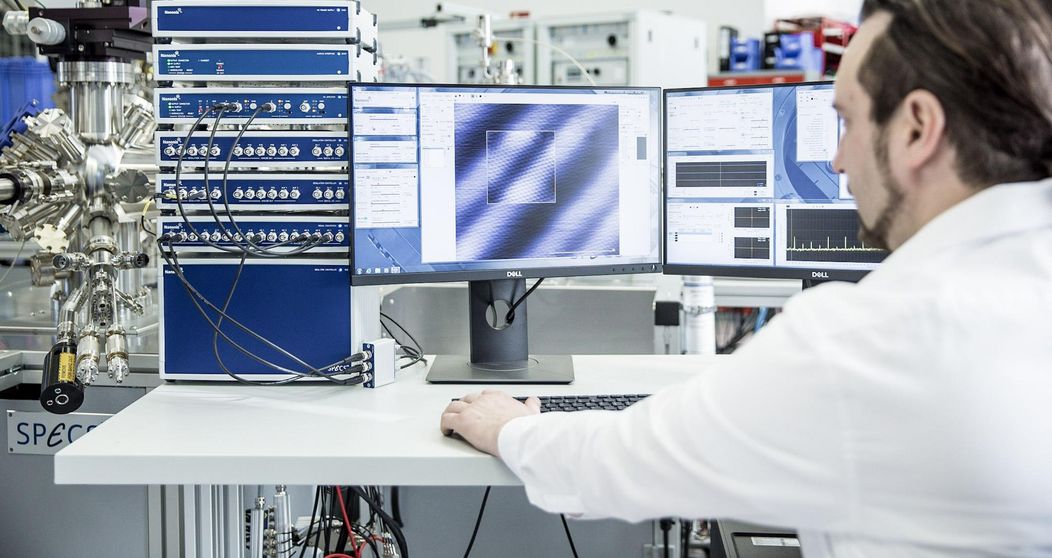The introduction of the BP5e in 2019 saw several new features aimed at increasing data acquisition speed and adding the ability to seamlessly stream raw data. Such features make it possible to acquire data and decide at a later stage what to do with it, as no processing has been performed. These new features are not limited to raw ADC-data though: Acquisition modules like sweep, spectroscopy and scan modules have seen their maximum data throughput increase by a factor of 50 as well, offering video-rate data generation and acquisition. A soon to be released dual channel high resolution oscilloscope module will improve the visualization of raw data, which until now was limited to a single channel.
As previous generations of the Nanonis SPM Control system only allowed streaming of data after the internal 50 times oversampling, many users of the BP5e might not be familiar with the new possibilities offered by the V5e software architecture. This post summarizes the options available to Nanonis Mimea and Nanonis Tramea users.
Note that for Nanonis Tramea users, the features discussed here are also available in software V5 and not exclusive to software V5e.
Nanonis Mimea and Nanonis Tramea: dual-channel high resolution oscilloscope and spectrum analyzer (to be released soon)
The high-resolution oscilloscope and spectrum analyzer add-on module has been available for acquiring and visualizing data at up to the full sampling rate of the ADCs (or DACs) of 1 MS/s from the introduction of the V5 system. The module can visualize up to a million points and offers a 500'000 points FFT, together with all the graph handling options of the Nanonis software. Data can be recorded in burst mode, as well as recalled and pasted to the background of the graph area. With high-speed data streaming options available in software V5e, the focus of the module moves towards visualization.
A significant, soon to be released update, will transform the module into a dual channel oscilloscope. A better overview of the signals in the systems and in particular of raw input data is the result of this upgrade, which will be available automatically at no cost to all users who have the high-resolution oscilloscope licensed. The two channels can be saved to disk independently from and in addition to all other stream channels used by the modules described below.
This will be the first in a series of planned improvements to the module.
Nanonis Tramea: High-speed sweeper
The high-speed sweeper offers a sweep and a step axis, and can thus be used for 2D-measurements. Both axes are able to generate and acquire data at up to 1 MS/s. At that rate, up to 8 channels can be simultaneously acquired and streamed to disk, a number which increases to 14 at half the data rate or below. A pseudo-3D viewer displays the data in real-time and at up to video-rate. The data used for visualization use a different path than those streamed to disk and use decimation to avoid overloading the CPU of the host PC and interference with the data stream being written to disk. To reduce acquisition time for measurements requiring a very large amount of data, a single or dual sweep-reverse condition can be set.
Stored data can be converted to hdf5 with a built-in converter tool
Nanonis Mimea: High-speed spectroscopy
The high-speed spectroscopy module uses a similar architecture to that of the high speed sweeper described above, but limited to one axis. Also this module can acquire up to 8 channels at 8 MS/s or 14 channels at 500 kS/s or below, and offers all functions known from the bias- and Z-spectroscopy modules. In contrast to those, the module can drive any output and is not limited to the bias- or Z-outputs. When selecting "time" as a sweep parameter, the module continuously records data as a function of time.
Nanonis Mimea: Fast scan
Fast scanning is not an independent module, but a second scan engine integrated into the scan module. Clicking on the icon next to the scan tab toggles between the "classic" and the "stream" scan mode. The latter can scan at up to 1 Mpixel/s, corresponding to about 30 frames/s for an image with 128x128 pixels. As high-speed scanning requires more than just a fast scan engine, the scope of the fast scan option is not only to scan faster, but also to acquire higher resolution images in a reasonable time: A 5000x5000 pixel image can be obtained in less than one minute compared to more than 40 minutes for the "classic" scan engine. In "stream" mode, the scan engine can stream data to disk in the same way as the spectroscopy modules described above: up to 8 channels at 1 Mpixel/s or up to 14 channels at 500'000 kpixels/s or below.
